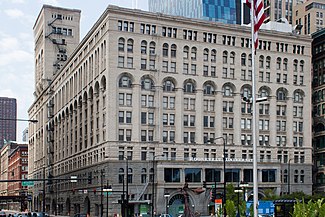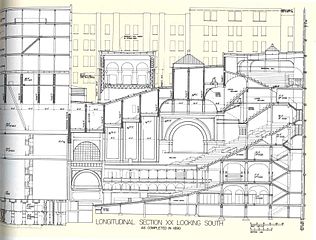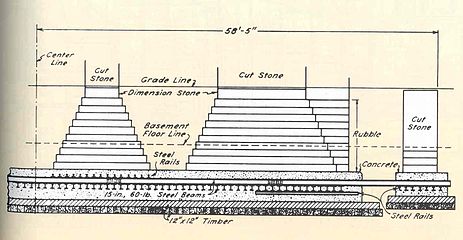
Louis Henry Sullivan was an American architect, and has been called a "father of skyscrapers" and "father of modernism." He was an influential architect of the Chicago School, a mentor to Frank Lloyd Wright, and an inspiration to the Chicago group of architects who have come to be known as the Prairie School. Along with Wright and Henry Hobson Richardson, Sullivan is one of "the recognized trinity of American architecture." The phrase "form follows function" is attributed to him, although the idea was theorised by Viollet le Duc who considered that structure and function in architecture should be the sole determinants of form. In 1944, Sullivan was the second architect to posthumously receive the AIA Gold Medal.

Dankmar Adler was a German-born American architect and civil engineer. He is best known for his fifteen-year partnership with Louis Sullivan, during which they designed influential skyscrapers that boldly addressed their steel skeleton through their exterior design: the Wainwright Building in St. Louis, Missouri (1891), the Chicago Stock Exchange Building (1894), and the Guaranty Building in Buffalo, New York (1896).

Ferdinand Wythe Peck (1848-1924) was a wealthy Chicago, Illinois, businessman and philanthropist, best known for financing Chicago's Auditorium Building.

The Wainwright Building is a 10-story, 41 m (135 ft) terra cotta office building at 709 Chestnut Street in downtown St. Louis, Missouri. The Wainwright Building is considered to be one of the first aesthetically fully expressed early skyscrapers. It was designed by Dankmar Adler and Louis Sullivan and built between 1890 and 1891. It was named for local brewer, building contractor, and financier Ellis Wainwright.

The Auditorium Theatre is a music and performance venue located in the Auditorium Building at 50 E. Ida B. Wells Drive in Chicago, Illinois. Inspired by the Richardsonian Romanesque Style of architect Henry Hobson Richardson, the building was designed by Dankmar Adler and Louis Sullivan and completed in 1889. The Chicago Symphony Orchestra performed in the theatre until 1904 as well as the Chicago Grand Opera Company and its successors the Chicago Opera Association and Chicago Civic Opera until its relocation to the Civic Opera House in 1929. The theater was home to the Joffrey Ballet from 1998 until 2020. It currently hosts a variety of concerts, musicals, performances, and events. Since the 1940s, it has been owned by Roosevelt University and since the 1960s it has been refurbished and managed by an independent non-profit arts organization.

Pilgrim Baptist Church is a historic church located on the south side of Chicago, Illinois, USA. The landmarked building was originally constructed for a synagogue, Kehilath Anshe Ma'arav. The church is notable both as an architectural landmark and for the cultural contributions by the congregation of the church. Located at 3301 S. Indiana Ave, the church is in the heart of Chicago's Bronzeville neighborhood. In 2017, the church was sold to the National Museum of Gospel Music.

The Guaranty Building, formerly called the Prudential Building, is an early skyscraper in Buffalo, New York. It was designed by Louis Sullivan and Dankmar Adler and completed in 1896. The building has been declared a National Historic Landmark and is located within the Joseph Ellicott Historic District.

Chicago College of Performing Arts is a performing arts college that is housed at Roosevelt University in Chicago, Illinois, United States.

The Dexter Building was a landmark building located at 630 South Wabash Avenue, in the South Loop area of Chicago, Illinois. The building was designed by the firm of Dankmar Adler and Louis Sullivan, and built in 1887. Prior to its destruction in 2006 it was one of the earliest surviving Louis Sullivan buildings, and was considered a precursor of the nearby Auditorium Building. It was designated as a Chicago Landmark in 1996 and was described by the Landmarks Division of the City of Chicago Department of Planning and Development as an "irreplaceable link in the chain of work of one of the nation's most important architectural partnerships". It was distinctive in its use of exterior perforated girders, prefiguring designs of seven decades later.

The Walter H. Gale House, located in the Chicago suburb of Oak Park, Illinois, was designed by Frank Lloyd Wright and constructed in 1893. The house was commissioned by Walter H. Gale of a prominent Oak Park family and is the first home Wright designed after leaving the firm of Adler & Sullivan. The Gale House was listed on the U.S. National Register of Historic Places on August 17, 1973.
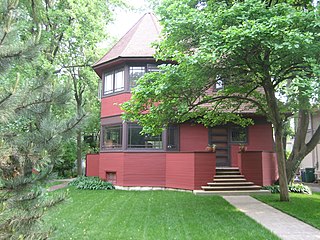
The Robert P. Parker House is a house located in the Chicago suburb of Oak Park, Illinois, United States. The house was designed by American architect Frank Lloyd Wright in 1892 and is an example of his early work. Real-estate agent Thomas H. Gale had it built and sold it to Robert P. Parker later that year. The house was designed by Wright independently while he was still employed by the firm Adler & Sullivan, run by engineer Dankmar Adler and architect, Louis Sullivan; taking outside commissions was something that Sullivan forbade. The Parker House is listed as a contributing property to a U.S. federally Registered Historic District.

The Thomas H. Gale House, or simply Thomas Gale House, is a house located in the Chicago suburb of Oak Park, Illinois, United States. The house was designed by famous American architect Frank Lloyd Wright in 1892 and is an example of his early work. The house was designed by Wright independently while he was still employed in the architecture firm of Adler & Sullivan, run by engineer Dankmar Adler and architect, Louis Sullivan; taking outside commissions was something that Sullivan forbade. The house is significant because of what it shows about Wright's early development period. The Parker House is listed as contributing property to a U.S. federally Registered Historic District. The house was designated an Oak Park Landmark in 2002.
John Mills Van Osdel was an American architect who is considered the first Chicago architect. He is considered a peer of the most prominent architects in the history of Chicago. He has also done significant work throughout Illinois and the Midwest, although much of it no longer exists.
Currently there are 124 properties listed on the National Register of Historic Places in Central Chicago, out of more than 350 listings in the City of Chicago. Central Chicago includes 3 of the 77 well-defined community areas of Chicago: the historic business and cultural center of Chicago known as the Loop, as well as the Near North Side and the Near South Side. The combined area is bounded by Lake Michigan on the east, the Chicago River on the west, North Avenue on the north, and 26th Street on the south. This area runs 5.25 miles (8.45 km) from north to south and about 1.5 miles (2.4 km) from east to west.
Adler & Sullivan was an architectural firm founded by Dankmar Adler and Louis Sullivan in Chicago. Among its projects was the multi-purpose Auditorium Building in Chicago and the Wainwright Building skyscraper in St Louis. In 1883 Louis Sullivan was added to Adler's architectural firm, creating the Adler & Sullivan partnership. According to Architect Ward Miller:
Adler & Sullivan are most associated with being an innovative and progressive architectural practice, forwarding the idea of an American style and expressing this in a truly modern format. Their work was widely published and at the forefront of building construction. Their buildings and especially their multipurpose structures. .. were unequaled. Furthermore, the expression of a tall building, its structure with a definite base, middle section or shaft and top or cornice was a new approach for the high building design. These types of tall structures developed into a format.. .. Even today, the vertical expression of a building employs these design principals.
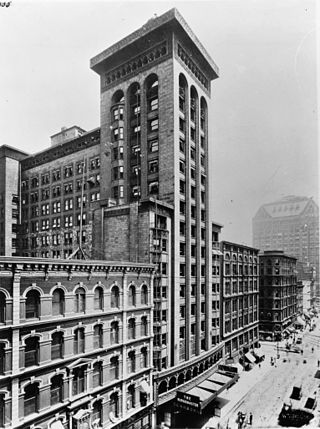
The Schiller Theater Building was designed by Louis Sullivan and Dankmar Adler of the firm Adler & Sullivan for the German Opera Company. At the time of its construction, it was among the tallest buildings in Chicago. Its centerpiece was a 1300-seat theater, which is considered by architectural historians to be one of the greatest collaborations between Adler and Sullivan.

Steinway Hall was an 11-story office building, and ground-floor theater, located at 64 East Van Buren Street in Chicago, Illinois. The theater had at least 14 names over the years, opening in 1896 as the Steinway Music Hall, and closing in the late 1960s as Capri Cinema. In the early 1900s, the building held the offices and nucleus of a group of famous Chicago architects that included a young Frank Lloyd Wright. These architects, inspired by the Arts and Crafts Movement and the philosophies of Louis Sullivan, formed what would become known as the Prairie School.

Central Music Hall (1879–1900) was a mixed-use commercial building and theater in Chicago, situated on the southeast corner of State and Randolph Streets. It was designed by celebrated German-born American architect Dankmar Adler. It was the first important building designed by the famous architect, in which he made initial use of his knowledge of acoustics. The building was demolished in 1900, around the same time Adler died, in order to build the Marshall Field & Company store, now Macy's.

McVicker's Theater (1857–1984) was a playhouse in Chicago, Illinois, United States. Built for actor James Hubert McVicker, the theater was the leading stage for comedic plays in Chicago's early years. It often hosted performances by Edwin Booth, who married McVicker's daughter and was once targeted there in an attempted murder. Adler & Sullivan designed a remodel in 1883. Although destroyed in two fires, including the Great Chicago Fire, McVicker's remained an operating theater until 1984. It was demolished the next year.

The Pueblo Opera House was a theater built in Pueblo, Colorado, and opened in 1890. The building was completely destroyed by a fire in 1922.
